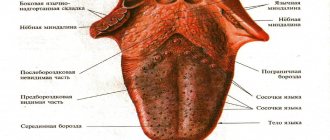What is granuloma annulare?
Granuloma annulare is a common skin condition characterized by smooth, discolored plaques. Plaques are outlined, palpable lesions are more than 1 cm in diameter; most plaques are raised. Plaques can form as a result of the fusion of papules. Most plaques are raised, but they can also be thickened areas without being noticeably raised above the surface of the skin. They may have clearly defined or poorly defined boundaries. They are usually thickened and ring-shaped. Granuloma annulare is more correctly known as necrobiotic papulosis. There are several clinical patterns.
Pathogenesis
The pathological process can last several months, or even several years. It presumably begins with a lymphocytic immune reaction, leading to the activation of macrophages and degradation of connective tissue, mediated by cytokines , which leads to the formation of a lenticular papule, which has a clearly defined, somewhat atrophic retraction in the central part, which grows with remitting progression, sometimes accelerating, sometimes slowing down in growth .
The granuloma annulare itself is a plaque measuring 5 square cm or more, slightly rising above the surface of the healthy skin and only matching the tone with it in the center. The skin easily gathers into folds, but around the sunken area there is a dense, waxy, shiny burgundy or slightly pinkish ring or crescent, which is not a very wide ridge (up to 2-3 mm). It may consist of individual grayish papules with pinkish rims that are not fused to the underlying layers of skin.
Granuloma annulare plaque
The rings are sharply defined, with their inner edges descending into sunken central areas. Thanks to palpation, a tumor-like neoplasm can be detected in the thickness of the epithelium, which gradually passes into the surrounding integument. In its structure, it has epithelioid cells and fibroblasts, which are surrounded on the periphery predominantly by lymphoid cells, as well as less common plasma cells and mast cells. The location of the round cell infiltrate is along the main course of the vessels, accompanied by the formation of powerful plexuses from argentophilic fibers. The separation of nodes occurs due to trabeculae and collagen fibers. The central parts are pronounced foci of necrosis and destruction of elastic fibers. The walls of the vessels gradually thicken, endothelial proliferation is observed, which can lead to blockage of individual vessels.
Annular granulomas can be located in the deep layers of the skin itself and even in the subcutaneous fat. They are felt as a peculiar type of nodules, reminiscent of dense peas or beans, which do not change the structure of the skin on the surface.
What causes Granuloma Annulare disease?
Granuloma annulare is a delayed hypersensitivity reaction to any component of the dermis. Inflammation is mediated by tumor necrosis factor alpha (TNFa). The reason why this happens is unknown.
Localized granuloma annulare is sometimes associated with autoimmune thyroiditis, but it does not clear up with thyroid replacement. Extensive granuloma annulare is sometimes associated with diabetes mellitus, hyperlipidemia, and rarely with lymphoma, HIV infection, and tumors.
Atypical granuloma annulare
Atypical granuloma annulare describes:
- Granuloma annulare in unusual places such as the face, palms and ears
- Granuloma annulare with photosensitive distribution
- Unusually severe or symptomatic granuloma annulare
- Interstitial granulomatous dermatitis
Interstitial granulomatous dermatitis is a pathological entity noted in some patients with extensive granuloma annulare or other disorders with a similar clinical picture.
Recommendations of Dr. Komarovsky
Dr. Komarovsky recommends, in addition to the basic treatment measures for granuloma annulare in children, to take measures to protect the affected area of the skin .
The units should not be subject to clothing friction, injury or other mechanical stress. Such factors can aggravate the situation and cause negative consequences.
Doctor advises:
- observe the rules of personal hygiene and prevent contamination of the affected areas of the skin;
- treat affected areas with prescribed ointments;
- if the disease does not go away for a long time or is prone to frequent relapses, then radical measures must be taken (injections, liquid nitrogen treatment procedures, etc.);
- When treating a disease, one must use the tactic of waiting for its self-healing.
How to remove lice and nits from a child? Find out the answer right now.
What treatment is available for Granuloma Annulare?
In most cases, granuloma annulare does not require any treatment because it disappears on its own after a few months, leaving no trace. However, sometimes plaques persist for years. Treatment is not always successful.
Local therapy
Options to consider include:
- Topical corticosteroid ointments by occlusion
- Intravenous steroid injections
- Destruction by cryotherapy or laser ablation
- Imiquimod cream
- Topical calcineurin inhibitors (tacrolimus and pimecrolimus)
Systemic therapy
Systemic therapy may be considered for advanced granuloma annulare. The following treatments have been reported to help in at least some cases of disseminated granuloma annulare. None of this can be relied upon and there are some potential adverse consequences.
- Systemic steroids
- Isotretinoin
- Methotrexate
- Potassium iodide
- Dapsone
- Plaquenil
- Pentoxifylline
- Allopurinol
- Combination of antibiotics once a month: rifampicin, ofloxacin, minocycline
- Photochemotherapy (PUVA)
- Phototherapy UVA1
- Photodynamic therapy
- Cyclosporine
- Biologics, particularly TNFα inhibitors such as adalimumab and infliximab
Publications
Granuloma annulare (granuloma anulare, anular granuloma) is a chronic, slowly progressive, relapsing benign granulomatous dermatosis of unknown etiology.
Historical information. The skin disease known as granuloma annulare was first described in 1895 by Englishman Thomas Fox under the name “Ringed eruption of the fingers” [2]. In 1908, G. Little analyzed all descriptions of granuloma annulare known at that time and identified it as a separate disease [12]. He was the first to suggest a relationship between granuloma annulare and tuberculosis infection. Later, atypical forms of granuloma annulare were described. For example, in 1938, dermatologist S. Monash first mentioned a case of a common form of granuloma annulare [14]. The first description of the pathomorphological picture of granuloma annulare is found in an article by V. Dubreuil, published in 1895. The author described the dermal histiocytic infiltrate, the absence of changes in the epidermis, areas of destruction of collagen fibers - signs known today as the classic signs of granuloma annulare [5].
Epidemiology of granuloma annulare. The incidence of granuloma annulare is not known. Granulomas occur at any age. There are two age periods for the onset of the disease. Approximately 70% of patients are young people under 30 years of age, in whom the disease is predominantly mild and often goes away on its own. The second group of patients are people over 50 years old. In this age period, the disease is usually combined with a number of pathologies of internal organs and is difficult to treat.
Etiology. The causes of granuloma annulare are not known. One of the largest groups of patients with granuloma annulare (100 people) was described in 1989 by K. Dabsky and R.K. Winkelman, who noted that in 21% of patients the disease was associated with diabetes mellitus [3]. Proving the relationship between the two diseases is difficult because the incidence of diabetes in the United States is quite high. The authors also suggested that the disease may occur as a result of excessive solar radiation and as a result of an adverse reaction due to medication. These assumptions, however, were not supported by convincing evidence.
There are several reports of the occurrence of granuloma annulare in children after vaccination [8, 16, 26]. A certain role in the occurrence of granuloma annulare is played by chronic infections, sarcoidosis, rheumatism, tuberculosis, hepatitis B. The granulomatous process is considered in this case not as a result of altered tissue reactivity. Great importance is attached to allergic reactions. A combination of granuloma annulare and autoimmune thyroiditis has been described [21].
The occurrence of granuloma annulare is the result of a delayed-type hypersensitivity reaction that occurs in response to an unknown antigen. The infiltrate is dominated by Th1 lymphocytes that produce IFN-γ and cause collagen degeneration [4, 9, 25].
Clinical picture and classification. The most common form of granuloma annulare found in the literature is limited . This form is characterized by the appearance of small (3-4 mm in diameter), dermal nodules of dense elastic consistency, flesh-colored or pinkish-brown, which are grouped into rings, semi-rings, and arcs. The size of the lesions varies from 1 to 5 cm or more. The center of the lesion sinks somewhat, giving the impression of skin atrophy. The rashes do not peel off. Typical localization is the skin of the back of the hands (feet), phalanges of the fingers, the extensor surface of the back of the elbow and knee joints, the anterior surface of the legs, i.e. in places where the skin is most susceptible to mechanical trauma and least protected by a layer of subcutaneous tissue (Fig. 1).
Rice. 1. Localized granuloma annulare on the forefoot
Disseminated granuloma annulare is characterized by the presence of multiple disseminated foci of granuloma annulare. The vast majority of patients are over 50 years of age. In these cases, the rashes are multiple, scattered or merging, which can give the lesions a reticular character, but without a significant tendency to a ring-shaped arrangement. In this form, the papular rash is skin-colored or purple in color. This form occurs in persons with carbohydrate metabolism disorders and diabetes mellitus.
In the papular form of granuloma annulare, the papules are located isolated from each other. The rash in this form is monomorphic, consists of sharply limited, rather deep-lying nodular elements of dense consistency with a diameter of 4-6 mm in the dermis. Their shape is hemispherical, their outlines are round or polygonal. The elements are slightly shiny, pearlescent, pinkish or the color of normal skin, sometimes reminiscent of keloids. The preferred location is the back of the hands and feet; less commonly, rashes are located on the skin in the area of the knee and elbow joints, neck, forearms, and buttocks. Papules accompany the typical annular rash of granuloma annulare. Eruptions similar to the papular form of granuloma annulare have been described in children exposed to Culicoides furans mosquito bites. Bite-associated rashes are accompanied by eosinophilia, and the typical ring-shaped elements are absent [15].
The deep form of granuloma annulare was described for the first time by A. Barzilai et al. in 2005. The condition should be differentiated from rheumatoid nodules [19]. This type of granuloma annulare is usually located on the scalp, elbows, forearms, dorsum of the hands, fingers, legs, and rarely in the periorbital region. The clinical picture is of skin or subcutaneous mobile nodes tightly connected to the periosteum.
The term “ perforating granuloma annulare ” was first used by D. Owens in 1971 [18]. With this form, a papular rash with a horny plug in the center is observed on the hands and fingers, from which a gelatin-like liquid is secreted, then crusts and lesions with an umbilical depression in the center are formed, then atrophic scars can form. The histological features of perforating granuloma annulare are the superficial location of the granulomas, in which they are injured and “removed” through the epidermis. A similar picture occurs with perforating collagenosis and metabolic diseases (diabetes mellitus, renal failure, etc.).
Cases of erythematous annular granuloma , when the rashes were located on open areas of the body and were infiltrated erythematous spots and papules. The histological picture of the cases described in the literature was consistent with interstitial histiocytic dermatitis. The condition should be differentiated from interstitial toxicoderma, which can be the result of ingestion of antihypertensive, lipid-lowering, antihistamines, and antidepressants [11].
In 1975, J. Obrian describes a special type of granuloma annulare - actinic granuloma , the rashes of which were located on the back of the neck - on skin exposed to solar insolation [17]. According to J. Obrian, a feature of this form of granuloma annulare was the presence of giant multinucleated histiocytes, sometimes including degenerated elastic fibers. However, this symptom also occurs in classical forms of granuloma annulare when the elements are located on open areas of the skin, which does not allow actinic granuloma to be identified as a separate form of the disease.
Often, a combination of several clinical forms can be identified in the same patient (Fig. 2).
Rice. 2. Patient A., 46 years old. Diagnosis: granuloma annulare. A – disseminated rashes on the skin of the abdomen, B – deep granuloma annulare on the back of the neck
Pathomorphological picture of granuloma annulare. In pathological examination, two types of granuloma annulare are distinguished: front garden type and interstitial type [10]. In the front garden type, a granulomatous infiltrate is noted in the papillary dermis in the center of which there are mucin deposits, surrounded by histiocytes and lymphocytes in the form of a palisade (Fig. 3).
Rice. 3. Front garden type of granuloma annulare. A – no changes in the epidermis, B – granulomatous infiltrate with mucin in the center and radially located histiocytes and lymphocytes along the periphery
In the interstitial type of granuloma annulare, accumulations of mucin and histiocytes are located between the fibers of the dermis (Fig. 4). Degeneration of collagen fibers can be observed in any histological type of granuloma annulare, but is limited in nature, unlike necrobiosis lipoidica.
Rice. 4. Interstitial type of granuloma annulare. A - no changes in the epidermis, B - mucin and histiocytes between the fibers of the dermis
Differential diagnosis of granuloma annulare. The disease must be distinguished from tuberculoid leprosy, cutaneous tuberculosis, tubercular syphilis, persistent elevated erythema, small nodular sarcoidosis, necrobiosis lipoidica, and rheumatic nodules.
Tuberculosis and leprosy are excluded based on the results of a pathomorphological examination using Ziehl-Nelssen staining, as well as on the basis of PCR examination of tissue. Skin tuberculosis (with the exception of atypical mycobacteria), as a rule, is accompanied by damage to the lungs or other organs.
The differential diagnosis of tubercular syphilide and granuloma annulare does not present any significant difficulties. The presence of ulceration of the tubercles with the subsequent development of focal mosaic scars, often positive specific serological reactions help in making the correct diagnosis.
With persistent raised erythema, the rash is more often localized around large joints than with granuloma annulare; they are larger in size and have a more acute inflammatory nature. Typically, the consistency of the nodules changes from soft (at the beginning of the disease) to hard (fibrotic). The nodules usually have a less pronounced tendency to group into ring-shaped lesions and form a recess in the center. Significant histomorphological differences are also noted. Persistent raised erythema is characterized by changes characteristic of leukocytoclastic vasculitis (fibrin deposits in the walls of blood vessels, the presence of neutrophils and “nuclear dust” of neutrophils). In the later stages of persistent raised erythema, sclerosis is noted [10].
Granuloma annulare differs from the small nodular form of sarcoidosis in its preferred localization (the area of small joints of the hands and feet, while in sarcoidosis the rashes are scattered, the skin of the face is often affected, the mucous membranes of the mouth and nose may be involved in the process), the color of the rashes (pale pink in annular granuloma; bluish or brownish in sarcoidosis). The diagnosis of sarcoidosis is established when clinical and radiological signs are confirmed histologically by the presence of noncaseating epithelioid cell granulomas. In the early stages (I and II), radiological data may be sufficient for diagnostic purposes. Diagnosis can be confirmed by transbronchial biopsy. In patients with active pulmonary sarcoidosis, serum angiotensin-converting enzyme (ACE) levels are usually elevated and the test becomes negative with treatment [4].
The differential diagnosis of granuloma annulare and the annular form of necrobiosis lipoidica can be much more difficult. In these cases, such signs as the predominant development of necrobiosis lipoidica in middle age, often in persons with impaired carbohydrate metabolism, and its preferential localization on the legs are taken into account. Pathomorphological differences are the deeper location of the infiltrate in necrobiosis lupoidum, the presence of plasma cells in the infiltrate, pronounced necrosis of collagen fibers, and the absence of mucin.
Rheumatic nodules, unlike nodules with granuloma annulare, are more often localized in the area of large joints; they are larger and lie deeper, located isolated or in groups consisting of several nodules. Unlike nodules in granuloma annulare, which are not accompanied by subjective sensations, rheumatic nodules are painful when pressed. On pathological examination, rheumatic nodules are characterized by large foci of collagen degeneration located deep in the dermis or subcutaneous fat, predominantly histiocytic and fibroblastic cellular infiltration with an admixture of plasma cells and lymphocytes.
Treatment of granuloma annulare. Treatment for granuloma annulare is often carried out on an outpatient basis. In our opinion, the use of systemic therapy, especially for limited forms, is unjustified. In children, the disease rarely requires treatment and goes away on its own within a year. If the disease persists, strong external corticosteroid medications may be recommended (for example, clobetasol propionate cream or ointment - “ Psoriderm ”, Pharmacare Inc.) [1]. Local corticosteroids of weak and moderate activity in the treatment of granuloma annulare are ineffective, since the inflammatory infiltrate is located in the dermis. Corticosteroids (triamcinolone) can be injected into the lesions.
Single lesions can be removed surgically or by laser or cryodestruction. There are known cases of reverse involution of granuloma annulare foci when taking a biopsy from the lesion [22].
The most difficult treatment is for disseminated granuloma annulare, associated with metabolic disorders. In such cases, niacin (vitamin B3) 500 mg 3 times a day, antimalarial drugs (hydroxychloroquine 6 mg/kg/day), dapsone (100 mg per day) are used [3, 23, 24]. There are known cases of effective therapy for disseminated granuloma with isotretinoin and cyclosporine [6, 7, 20]. Physiotherapeutic methods that can be used are PUVA therapy and ultraviolet B spectrum radiation.
Literature:
- Kozlovskaya, V.V. The use of Psoriderm cream in the treatment of chronic dermatoses / V.V. Kozlovskaya // Medical news. – 2010. – No. 5-6. – pp. 83-86.
- Colcott-Fox, T. Ringed eruption of the fingers / T. Colcott-Fox // Br. J. Dermatol. – 1895. – P. 91-92.
- Dabski, K. Generalized granuloma annulare: clinical and laboratory findings in 100 patients / K. Dabski, RK Winkelmann // Journal of the American Academy of Dermatology. – 1989. – Vol. 20. – P. 39-47.
- Dermatology / J. Bolognia et al. – Mosby, 2003. – P. 2500.
- Dubreuilh, W. Eruption circinée chronique de la main / W. Dubreuilh // Ann. Dermatol. Syphiligr. – 1895. – P. 335-338.
- Fiallo, P. Cyclosporin for the treatment of granuloma annulare / P. Fiallo // Br. J. Dermatol. – 1998. – Vol. 138. – P. 369-370.
- Generalized granuloma annulare in a patient with type II diabetis mellitus: successful treatment with Isotretinoin / M. Sahin at al. // Journal of the European Academy of Dermatology and Venereology. – 2006. – Vol. 20. – P. 111-113.
- Granuloma annulare following BCG vaccination / C. Houcke-Bruge et al. //Ann. Dermatol. Venerol. – 2001. – Vol. 128. – P. 541–544.
- Hanna, W.M. Granuloma annulare: an elastic tissue disease? Case report and literature review / WM Hanna, F. Moreno-Merlo, L. Andrighetti // Ultrastruct. Pathol. – 1999. – Vol. 23. – P. 33-38.
- Histologic Diagnosis of Inflammatory Skin Diseases, third ed. / AB Ackerman et al. - New York: “Ardor Scribendi”, 2005. – 522 rub.
- Interstitial granulomatous drug reaction with a histological pattern of interstitial granulomatous dermatitis / C. Perrin et al. //Am. J. Dermatopathol. – 2001. – Vol. 23. – P. 295-298.
- Little, E. Granuloma annulare / E. Little // Br. J. Dermatol. – 1908. – P. 213.
- Ma, A. Response of generalized granuloma annulare to high-dose niacinamide / A. Ma, M. Medenica // Arch. Dermatol. – 1983. – Vol. 119. – P. 836-839.
- Monash, S. Granuloma annulare disseminatum / S. Monash // Arch. Dermatol. Res. – 1932. – P. 122-131.
- Moyer, DG Papular Granuloma Annulare / DG Moyer // Arch. Dermatol. – 1964. – Vol. 89. – P. 41-45.
- Multiple lesions of granuloma annulare following BCG vaccination: case report and review of the literature / M. Kakurai et al. // Int. J. Dermatol. – 2001. – Vol. 9. – P. 579.
- O`Brien, JP Actinic granuloma. An annular connective tissue disorder affecting sun- and heat-damaged (elastic) skin / JP O`Brien // Arch. Dermatol. – 1975. – Vol. 111. – P. 460-466.
- Owens, DW Perforating granuloma annulare / DW Owens, RG Freeman // Arch. Dermatol. – 1971. – Vol. 103. – P. 64-67.
- Pseudorheumatoid nodules in adults: a juxta-articular form of nodular granuloma annulare / A. Barzilai et al. //Am. J. Dermatopathol. – 2005. – Vol. 27. – P. 1-5.
- Ratnavel, RC Perforating granuloma annulare: response to treatment with Isotretinoin / RC Ratnavel, PG Norris // Journal of the American Academy of Dermatology. – 1995. – Vol. 32. – P. 126-127.
- Report, C. Localized granuloma annulare and autoimmune thyroiditis: a new case report / C. Report // Journal of the American Academy of Dermatology. – 2000. – P. 943-945.
- Resolution of patch-type granuloma annulare lesions after biopsy / N. Levin et al. // Journal of the American Academy of Dermatology. – 2002. – Vol. 46. – P. 426-429.
- Simon, Jr.M. Antimalarials for control of disseminated granuloma annulare in children / Jr.M. Simon, P. Von den Driesch // Journal of the American Academy of Dermatology. – 1994. – Vol. 31. – P. 1064-1065.
- Steiner, A. Sulfone treatment of granuloma annulare / A. Steiner, H. Pehamberger, K. Wolff // Journal of the American Academy of Dermatology. – 1985. – Vol. 13. – P. 1004-1008.
- Umbert, P. Histologic, ultrastructural, and histochemical studies of granuloma annulare / P. Umbert, RK Winkelmann // Arch. Dermatol. – 1977. – Vol. 113. – P. 1681-1686.
- Wolf, F. Generalized granuloma annulare and hepatitis B vaccination / F. Wolf, P. Grezard, F. Berard // Journal of the European Academy of Dermatology and Venereology. – 1998. – Vol. 8. – P. 435–436.
Kozlovskaya V.V., Abdel M.V.
Gomel State Medical University, Gomel, Belarus








